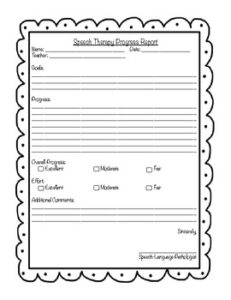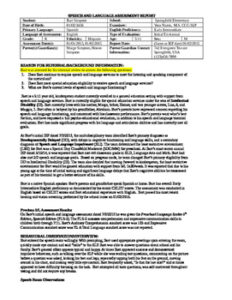In the world of speech pathology, effective communication is paramount. We spend our days helping individuals find their voice, articulate their thoughts, and connect with the world around them. But beyond direct therapy, one of our most crucial communication tools is the assessment report. These documents are more than just paperwork; they are comprehensive narratives that detail a client’s communication profile, guide intervention, and inform other professionals involved in their care.
Crafting a thorough, insightful, and clear assessment report can often feel like a daunting task. It requires meticulous attention to detail, a deep understanding of assessment data, and the ability to synthesize complex information into an accessible format. From initial client contact to the final recommendations, every piece of information needs to be systematically organized and presented, ensuring nothing important is overlooked.

That’s where the value of a well-structured speech pathology assessment report template truly shines. It provides a foundational framework, streamlining the report-writing process, ensuring consistency, and allowing you to focus your energy on the unique needs of each client rather than reinventing the wheel with every new assessment. Let’s explore what makes these templates so indispensable for practitioners.
Demystifying the Anatomy of a Comprehensive Speech Pathology Assessment Report
A high-quality speech pathology assessment report is a cornerstone of professional practice. It serves multiple purposes, from documenting a client’s current communication status to justifying treatment plans and facilitating interdisciplinary collaboration. Think of it as a detailed map that guides everyone involved in the client’s journey, from the referring physician to the client’s family. A strong report is built on several key sections, each contributing to a holistic picture.
Typically, the report begins with essential client identification information, followed by a detailed account of their background history. This section is crucial for understanding the client’s developmental milestones, medical history, educational background, and any prior therapeutic interventions. It helps contextualize their current communication challenges and provides valuable insights into potential contributing factors.
The core of the report lies in the assessment methods and findings. Here, you’ll meticulously document the standardized tests administered, informal observations made, and any interview information gathered. This section should include specific test scores, descriptive summaries of performance, and qualitative observations regarding the client’s communication behaviors, strengths, and areas of need in various contexts.
Following the data presentation, the report moves into diagnostic impressions and a prognosis. This is where you synthesize all the collected information to formulate a clinical diagnosis, if applicable, and describe the severity of the communication impairment. The prognosis offers an informed opinion on the likely course and outcome of the client’s communication development or recovery with intervention.
Finally, and perhaps most importantly, the report concludes with clear and actionable recommendations and a plan of care. This section outlines specific goals for therapy, suggested interventions, strategies for home practice, and any referrals to other specialists. It transforms the assessment data into a practical roadmap for intervention, making the report a truly dynamic and useful document.
Essential Components to Include
- Client Identification and Demographics
- Background History and Relevant Medical Information
- Referral Source and Reason for Assessment
- Assessment Tools and Procedures Utilized
- Summary of Findings (Quantitative and Qualitative)
- Analysis of Strengths and Areas of Need
- Diagnostic Impression and Severity Statement
- Prognosis for Communication Improvement
- Goals and Specific Recommendations for Intervention
- Suggestions for Home Practice and Environmental Modifications
- Signature and Credentials of the Assessing Speech Pathologist
- Date of Assessment and Report Completion
Why a Dedicated Template Transforms Your Reporting Workflow
Adopting a robust speech pathology assessment report template isn’t just about ticking boxes; it’s about elevating the quality and efficiency of your professional output. One of the most immediate benefits is the significant time savings. Instead of starting from scratch each time, you have a pre-structured document that guides your input, allowing you to dedicate more brainpower to clinical reasoning and less to formatting and remembering every single section you need to include.
Templates also foster consistency across all your reports. This means that regardless of the client or the specific assessment, your reports will maintain a professional and uniform appearance, making them easier for other professionals and family members to read and understand. This consistency not only enhances your professional image but also ensures that no critical information is accidentally omitted, reducing the risk of errors and improving the overall quality of care.
Furthermore, a good speech pathology assessment report template is designed to be adaptable. While it provides a standardized framework, it also offers flexibility for customization. You can tailor sections to fit specific client needs, different assessment contexts (e.g., school-based versus private practice), or to integrate unique aspects of your clinical approach. This balance between structure and flexibility is key to making a template a truly valuable asset in your daily practice.
- Significantly reduces report writing time
- Ensures all critical components are consistently included
- Promotes a professional and uniform presentation
- Minimizes the potential for omissions or errors
- Facilitates quick and clear communication among stakeholders
- Offers a flexible structure that can be customized for diverse cases
- Supports ethical practice by maintaining comprehensive documentation
Ultimately, a well-crafted assessment report is a testament to your clinical expertise and your commitment to your clients. It bridges the gap between complex diagnostic processes and understandable, actionable information. By embracing the power of structured reporting tools, you not only streamline your administrative tasks but also enhance the clarity and impact of your professional evaluations, ensuring that every client receives the thoughtful, detailed attention they deserve.
Investing time in developing or selecting an effective template is an investment in your professional efficiency and the quality of care you provide. It empowers you to create comprehensive, coherent, and impactful documents that accurately reflect your clinical findings and guide meaningful interventions for all the individuals you serve.



